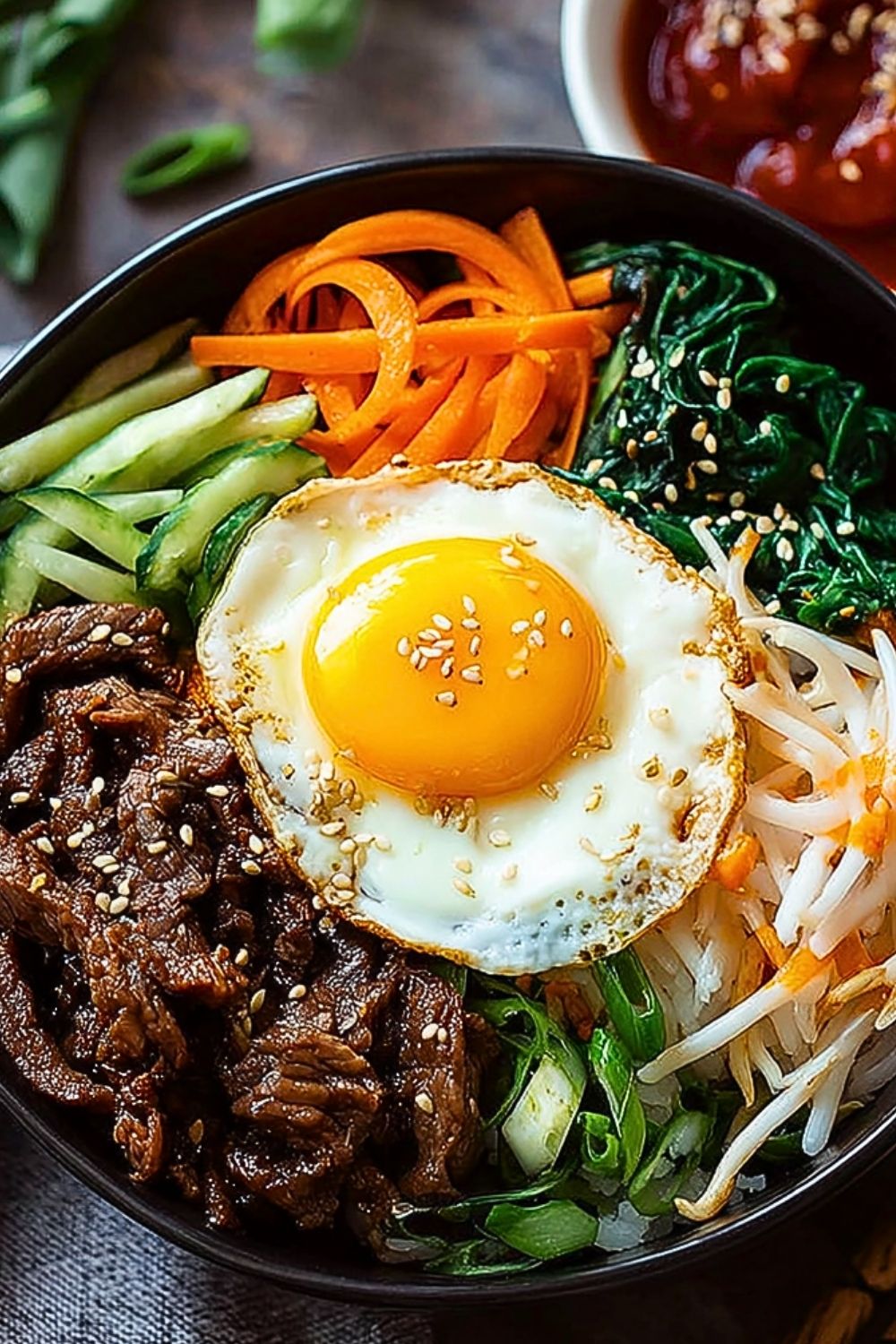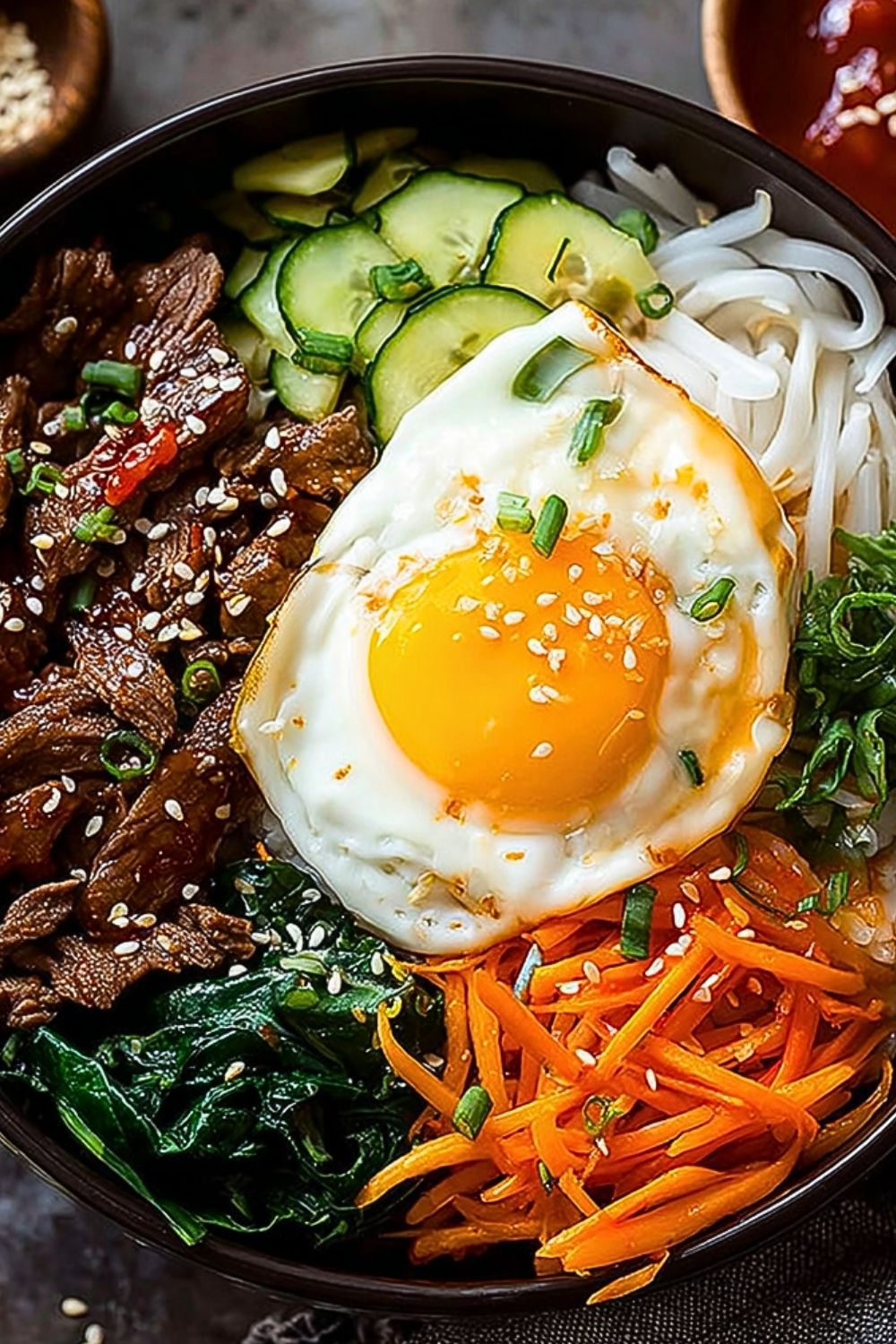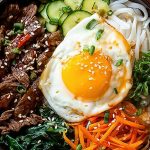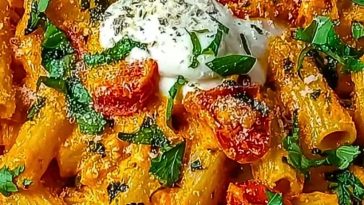When I first tasted Bibimbap, it was a flavor explosion I never forgot. The warm rice base, a medley of sautéed vegetables, savory marinated beef, and that iconic sunny-side-up egg—all brought together with a drizzle of spicy-sweet gochujang sauce. It’s not just a dish; it’s a full experience in a bowl, and ever since then, I’ve been making my own version at home.

This easy Korean Bibimbap recipe is my go-to when I want something nourishing yet exciting. It’s colorful, packed with texture, and every bite is uniquely satisfying. The best part? You can prep most of the ingredients ahead of time, making it perfect for a quick lunch or dinner that doesn’t sacrifice flavor.
Why You’ll Love This Easy Korean Bibimbap
Bibimbap is the kind of meal that adapts to your taste. Whether you’re craving something protein-packed or aiming for a plant-based bowl, it’s incredibly versatile. The variety of textures—from crunchy carrots to soft spinach—makes every mouthful interesting. Plus, it’s a smart way to use up leftover veggies in your fridge.
It’s healthy, filling, and visually stunning. That bright egg yolk and colorful vegetables make it Instagram-worthy without even trying. Most importantly, it tastes as good as it looks.
What Kind of Rice Should I Use?
Short-grain white rice is the classic base for Bibimbap, known for its slightly sticky texture that holds everything together beautifully. However, you can switch it up with brown rice or even quinoa for a healthier twist. Just make sure the rice is warm when you serve it—this is key to helping the flavors meld together.
Options for Substitutions
If you’re not a fan of beef, swap it with grilled chicken, tofu, or mushrooms for a vegetarian or vegan version. For the egg, a poached or soft-boiled egg works great if you don’t want to fry. Can’t find gochujang? Mix Sriracha with a touch of miso or soy sauce to mimic that sweet heat.
Gluten-free eaters can use tamari instead of soy sauce. And for added crunch, try topping your bowl with roasted seaweed or kimchi. Bibimbap is all about customization—make it your own.
Ingredients for this Easy Korean Bibimbap
White Short-Grain Rice – The hearty base of the dish. Its slightly sticky texture helps all the toppings bind together perfectly.
Beef (Ribeye or Sirloin, thinly sliced) – Marinated in a savory-sweet blend, this adds rich umami and depth to the bowl.
Carrots (Julienned) – Brings color, crunch, and a touch of natural sweetness.
Spinach – Lightly sautéed or blanched, it adds a soft texture and earthy note.
Bean Sprouts – A classic Korean vegetable that offers freshness and light crunch.
Zucchini (thinly sliced or julienned) – Sautéed with garlic, it enhances the bowl with moisture and mild flavor.
Gochujang (Korean red chili paste) – The key sauce that ties everything together with its spicy-sweet punch.
Soy Sauce, Sesame Oil, Garlic, Sugar – Used in the marinades and seasonings to build that unmistakable Korean flavor.
Eggs – Typically fried sunny-side-up, adding richness and a luscious yolk to stir through the rice.
Sesame Seeds – Sprinkled on top for nutty aroma and visual appeal.
Scallions (Chopped) – For freshness and sharpness to balance richer components.

Step 1: Cook the Rice
Start by rinsing the rice until the water runs clear. Cook it in a rice cooker or pot with a tight lid. You want the grains to be tender but slightly sticky—perfect for scooping with chopsticks. Keep it warm until serving.
Step 2: Marinate and Cook the Beef
In a bowl, mix thinly sliced beef with soy sauce, sesame oil, minced garlic, sugar, and a touch of black pepper. Let it marinate for at least 20 minutes (overnight is better). Sauté in a hot pan until caramelized and cooked through. Set aside.
Step 3: Prepare the Vegetables
Blanch bean sprouts and spinach separately in boiling water for 1-2 minutes. Drain and season each with a touch of sesame oil, garlic, and salt. Julienne the carrots and zucchini, then lightly sauté them with a dash of oil and garlic until just tender but still crisp.
Step 4: Fry the Egg
Fry eggs sunny-side-up in a lightly oiled skillet until the whites are set but yolks remain runny. This golden center becomes the creamy binder of the bowl.
Step 5: Make the Gochujang Sauce
In a small bowl, mix gochujang with a bit of sesame oil, sugar, water, and vinegar to loosen and balance the heat. Taste and adjust to your spice preference.
Step 6: Assemble the Bibimbap
Scoop warm rice into a wide bowl. Neatly arrange the vegetables, cooked beef, and egg on top in sections, like a colorful pinwheel. Drizzle the gochujang sauce over the top, and sprinkle with sesame seeds and scallions. Serve immediately and mix everything together before eating for the full experience.
How Long to Prepare the Easy Korean Bibimbap
Prep Time: If you’re prepping everything fresh, including slicing vegetables, marinating beef, and making the sauce, expect around 35–40 minutes. That includes time for boiling water, sautéing, and prepping rice if it’s not cooked ahead.
Cook Time: The actual cooking (rice, sautéing veggies, beef, and frying the egg) takes about 20–25 minutes. You can cut this time significantly if you meal-prep vegetables and sauce in advance.
Total time from start to serving is typically under 1 hour, and with pre-prepped components, it can be ready in just 20 minutes.
Tips for Perfect Easy Korean Bibimbap
- Use freshly cooked or reheated warm rice. Cold rice will not absorb the sauce well.
- Don’t overcook vegetables; each should retain its individual texture.
- Marinate the beef for longer if possible (even overnight) to deepen the flavor.
- For a richer bowl, drizzle extra sesame oil right before serving.
- Serve gochujang sauce on the side if guests prefer to control the heat level.
Watch Out for These Mistakes While Cooking
- Skipping vegetable seasoning: Each component should be seasoned lightly. Undressed veggies can make the dish taste flat.
- Overcrowding the pan: This leads to steaming instead of browning, especially for beef.
- Using cold rice: This makes the bowl feel disjointed. Always use warm rice.
- Burning the garlic: Keep the heat moderate when sautéing to avoid bitterness.
- Over-salting: Remember, gochujang and soy sauce are already salty—taste as you go.
What to Serve With Easy Korean Bibimbap?
1. Kimchi
Adds a spicy, fermented kick that contrasts beautifully with the fresh vegetables.
2. Miso Soup
A light soup balances the bold flavors of Bibimbap and provides a warm start.
3. Korean Pancakes (Pajeon)
Savory and crispy, these pair wonderfully with Bibimbap, especially for guests.
4. Pickled Radishes
Crunchy and tangy, they cut through the richness of the egg and beef.
5. Green Tea or Barley Tea
Traditional Korean beverages that help cleanse the palate.
Storage Instructions
Fridge: Store leftover Bibimbap components separately in airtight containers. Rice and vegetables will keep well for up to 3–4 days. The beef and gochujang sauce can be refrigerated for the same duration.
Freezer: Avoid freezing raw or fried eggs. However, the marinated (uncooked) beef and plain rice freeze well. Store in sealed freezer bags for up to 2 months.
Reheat: Warm the rice and toppings separately in a microwave or stovetop. Fry a fresh egg when ready to serve for best texture.
Estimated Nutrition (Per Serving)
- Calories: ~600
- Protein: 26g
- Fat: 20g
- Saturated Fat: 6g
- Carbohydrates: 72g
- Fiber: 5g
- Sugar: 10g
- Sodium: 850mg
Frequently Asked Questions
What does Bibimbap mean?
Bibimbap literally translates to “mixed rice” in Korean. It refers to mixing all the toppings with rice and sauce before eating.
Can I make Bibimbap vegetarian?
Absolutely. Swap beef for tofu, mushrooms, or simply add more seasoned vegetables.
Is Bibimbap served hot or cold?
Traditionally it’s served hot, but a cold version exists called “cold Bibimbap,” which is more popular in summer.
Can I use a different sauce instead of gochujang?
Yes. A mix of soy sauce, sesame oil, a bit of vinegar, and chili flakes can work in a pinch.
What’s the difference between Bibimbap and Dolsot Bibimbap?
Dolsot Bibimbap is served in a hot stone bowl that crisps the rice at the bottom—delicious but requires special cookware.
Conclusion
Easy Korean Bibimbap is the perfect combination of nutritious, flavorful, and visually stunning. It’s a flexible dish that encourages creativity—ideal for using leftover veggies or showcasing seasonal produce. Whether you’re cooking for one or a crowd, it never fails to impress. With this guide, you’ll be able to whip up a bowl of Bibimbap that hits all the right notes: savory, spicy, crunchy, and oh-so-satisfying.

Easy Korean Bibimbap
- Prep Time: 40 minutes
- Cook Time: 25 minutes
- Total Time: 65 minutes
- Yield: 2 servings 1x
- Category: Main Dish
- Method: Sautéing + Assembly
- Cuisine: Korean
Description
Easy Korean Bibimbap is a quick dinner idea that’s as nutritious as it is colorful. A vibrant mix of sautéed vegetables, marinated beef, perfectly cooked rice, and a runny fried egg comes together in this traditional Korean rice bowl. This easy recipe is ideal for anyone looking for healthy food ideas or unique breakfast ideas. The spicy-sweet gochujang sauce ties it all together, making it a satisfying, balanced meal you’ll want to make again and again.
Ingredients
1 cup short-grain white rice
200 g thinly sliced beef (ribeye or sirloin)
1 medium carrot, julienned
1 cup spinach
1 cup bean sprouts
1 small zucchini, julienned
2 tablespoons gochujang
2 tablespoons soy sauce
1 tablespoon sesame oil
1 teaspoon sugar
2 cloves garlic, minced
2 eggs
1 teaspoon sesame seeds
2 scallions, chopped
Instructions
1. Rinse and cook the rice until tender and slightly sticky. Keep warm.
2. Marinate the beef in soy sauce, sesame oil, garlic, and sugar for 20 minutes.
3. Sauté the beef until browned and cooked through. Set aside.
4. Blanch the spinach and bean sprouts separately. Season each with a bit of sesame oil, garlic, and salt.
5. Lightly sauté the julienned carrots and zucchini with a touch of oil until just tender.
6. Fry eggs sunny-side-up until whites are set but yolks remain runny.
7. Mix gochujang with a bit of sesame oil, sugar, water, and vinegar to create the sauce.
8. Scoop rice into a bowl. Neatly arrange vegetables, beef, and egg on top.
9. Drizzle with gochujang sauce, sprinkle with sesame seeds and scallions, and serve.
10. Mix thoroughly before eating to enjoy the full Bibimbap experience.
Notes
Prep vegetables ahead of time to cut down on cooking time later.
Adjust the gochujang to suit your spice tolerance—start with less and add more as desired.
For a crispy bottom layer, serve in a hot stone bowl (Dolsot style).
Nutrition
- Serving Size: 1 bowl
- Calories: 600
- Sugar: 10g
- Sodium: 850mg
- Fat: 20g
- Saturated Fat: 6g
- Unsaturated Fat: 11g
- Trans Fat: 0g
- Carbohydrates: 72g
- Fiber: 5g
- Protein: 26g
- Cholesterol: 185mg









